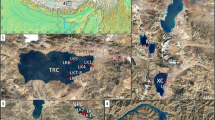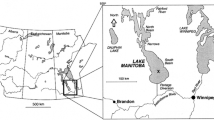Abstract
Lake Jilantai-Hetao, a megalake, was formed some time before 60–50 ka, along the Great North Bend of the Yellow River. The basin is now dry, with most of the area covered by aeolian sand. We are investigating this profound hydrologic change using a number of research approaches. Paleoshorelines of this megalake are best preserved in the Jilantai area in the southwestern portion of the megalake basin. We collected aquatic mollusk shells from littoral sediments at different altitudes around Jilantai and measured their strontium isotope compositions. 87Sr/86Sr ratios in shell carbonates are different between the high lake phase (~1,080–1,050 m altitude) and the low lake phase (~1,044–1,030 m altitude), with a small shift in average strontium ratios to more radiogenic values during the low lake phase. Based on regional hydrology and physical geography, we conclude that water from the Yellow River was the dominant water source supplying this megalake. 87Sr/86Sr ratios of modern water samples suggest the Yellow River was the dominant water source during the high lake phase, but that the relative contribution of Yellow River water to the megalake was reduced, and that the relative contributions of local precipitation and groundwater increased, during the low lake phase.






Similar content being viewed by others
References
Chen JS, Wang JY (2004) The impact of a underground reservoir found in the Badain Jaran Desert on the water transferring plan in Northwest China. J Econ Water Resour 22:28–32 (in Chinese with English Abstract)
Chen JS, Zhao X, Sheng XF, Dong HZ, Rao WB, Su ZG (2006) Formation mechanisms of megadunes and lakes in the Badain Jaran Desert, Inner Mongolia. Chinese Sci Bull 51:3026–3034
Chen J, Li GJ, Yang JD, Rao WB, Lu HY, Balsam W, Sun YB, Ji JF (2007) Nd and Sr isotopic characteristics of Chinese deserts: implications for the provenances of Asian dust. Geochim Cosmochim Acta 71:3904–3914
Chen FH, Fan YX, Chun X, Madsen DB, Oviatt CG, Zhao H, Yang LP, Sun Y (2008) Preliminary research on the Megalake Jilantai-Hetao in Late Quaternary. Chinese Sci Bull 53:1725–1739
Edmunds WM, Ma JZ, Aeschbach-Hertig W, Kipfer R, Darbyshire DPF (2006) Groundwater recharge history and hydrogeochemical evolution in the Minqin Basin, North West China. Appl Geochem 21:2148–2170
Faure G, Powell JL (1975) Strontium isotope geology. Scientific Printing House, Beijing (Chinese Edition)
Flusche MA, Seltzer G, Rodbell D, Siegel D, Samson S (2005) Constraining water sources and hydrologic processes from the isotopic analysis of water and dissolved strontium, Lake Junin, Peru. J Hydrol 312:1–13
Geng K, Chen YF (1990) Formation, development and evolution of Jilantai salt-lake, Inner Mongolia. Acta Geogr Sin 45:341–349 (in Chinese with English Abstract)
Geng K, Hu CY, Liu J (1989) Quaternary lake evolution in the Jilantai region. J Arid Land Resour Environ 3:26–32 (in Chinese)
Geological Bureau of Ningxia (1976) Areal geological survey report for Jilantai area, pp 8–99 (in Chinese)
Guo XY, Chen FH, Xie YW, Shi Q (1999) A study on modeling the terminal lake of Shiyang River Drainage Basin under the natural conditions. J Nat Resour 14:385–388 (in Chinese with English Abstract)
Guo HD, Liu H, Wang XY, Shao Y, Sun Y (2000) Subsurface old drainage detection and paleoenvironment analysis using spaceborne radar images in Alxa Plateau. Sci China Ser D 49:439–449
Hart WS, Quade J, Madsen DB, Kaufman DS, Oviatt CG (2004) The 87Sr/86Sr ratios of lacustrine carbonates and lake-level history of the Bonneville paleolake system. Geol Soc Am Bull 116:1107–1119
Liu XQ, Ge WS (2002) Remote sensing interpretation of regional geological characteristics and the formation and evolution of Jilantai Salt Lake. Oceanol Limnol Sin 33:145–150 (in Chinese with English Abstract)
Long H, Wang N, Li Y, Ma HZ, Zhao Q, Cheng HY, Huang YZ (2007) Mid-Holocene climate variations from lake records of the East Asian monsoon margin: a multiple proxy and geomorphological study. Quaternary Sci 27:371–381 (in Chinese with English Abstract)
Madsen DB, Chen FH, Oviatt CG, Zhu Y, Brantingham PJ, Elston GR, Bettinger RL (2003) Late Pleistocene/Holocene wetland events recorded in southeast Tengger Desert lake sediments, NW China. Chinese Sci Bull 48:1423–1429
Pan HZ, Zhu XG (2007) Early Cretaceous non-marine gastropods from the Xiazhuang formation in North China. Cretaceous Res 28:215–224
Pan BT, Wu GJ, Wang YX, Liu ZG, Guan QY (2001) Age and genesis of the Shagou River terraces in eastern Qilian Mountains. Chinese Sci Bull 46:510–515
Pan AF, Ma RY, Li RJ (2006) Study on the geochemistry of deep liquid in the Ordos Basin. Petrol-industry press, Beijing (in Chinese)
Pu W, Gao JF, Zhao KD, Ling HF, Jiang SY (2005) Separation method of Rb-Sr, Sm-Nd using DCTA and HIBA. J Najing Univ (Nat Sci) 41:445–450 (in Chinese with English Abstract)
Reihardt EG, Stanley DJ, Patterson RT (1998) Strontium isotopic paleontological method as a high-resolution paleosalinity tool for lagoonal environments. Geology 26:1003–1006
Unit 00919 of China People’s Liberation Army (1979) Areal geological survey report for Dengkou County area, pp 18–22 (in Chinese)
Wang FY (2001) Satellitic radar remote sensing studies on evolution of Jilantai Salt Lake. Remote Sens Land Resour 50:35–39 (in Chinese with English Abstract)
West G, Andrew R, Catt JA, Hart CP, Hollin JT, Knudsen KL, Miller GF, Penney DN, Pettit ME, Preece RC, Switsur VR, Whiteman CA, Zhou LP (1999) Late and middle Pleistocene deposits at Somersham, Cambridgeshire, U.K.: a model for reconstructing fluvial/estuarine depositional environments. Quaternary Sci Rev 18:1247–1314
Yan MC, Dong GR, Li BS, Li HM, Yang JL (1998) A preliminary study on the evolution of southeastern margin in the Tengger Desert. J Desert Res 18:111–117 (in Chinese with English Abstract)
Yang D, Fang XM, Dong GR, Peng ZC, Li JJ (2006) Aeolian deposit evidence for formation and evolution of the Tengger desert in the north of China since Early Pleistocene. Mar Geol Quat Geol 26:93–100 (in Chinese with English Abstract)
Yang LP, Chen FH, Chun X, Fan YX, SunY Madsen DB, Zhang XQ (2008) The Jartai Salt Lake shorelines in northwestern dryland China revealed by remote sensing images. J Arid Environ 72:861–866
Zhang HC, Ma YZ, Pen JL, Li JJ, Cao JX, Qi Y, Chen GJ, Fang HB, Mu DF, Pachur HJ, Wünnemann B, Feng ZD (2002) Palaeolake and palaeoenvironment between 42–18 ka BP in Tengger Desert, NW China. Chinese Sci Bull 47:1946–1956
Acknowledgments
We gratefully thank Associate Prof. Jin-Long Ma for his assistance in mollusk species identification, and Prof. W. M. Edmunds and Ms. Li Yang for their help in editing the manuscript. We appreciate two anonymous reviewers for their cogent comments and Prof. Mark Brenner for his insightful improvement to the final edition. This research was funded by a NSFC grant (40502016), a NSFC Innovative Research Team Project (40721061), and a NSFC key project (90502008). Measurement of strontium was supported by the Opening Foundation of the State Key Laboratory of Continental Dynamics, Northwest University.
Author information
Authors and Affiliations
Corresponding author
Rights and permissions
About this article
Cite this article
Fan, YX., Chen, FH., Wei, GX. et al. Potential water sources for Late Quaternary Megalake Jilantai-Hetao, China, inferred from mollusk shell 87Sr/86Sr ratios. J Paleolimnol 43, 577–587 (2010). https://doi.org/10.1007/s10933-009-9353-4
Received:
Accepted:
Published:
Issue Date:
DOI: https://doi.org/10.1007/s10933-009-9353-4




